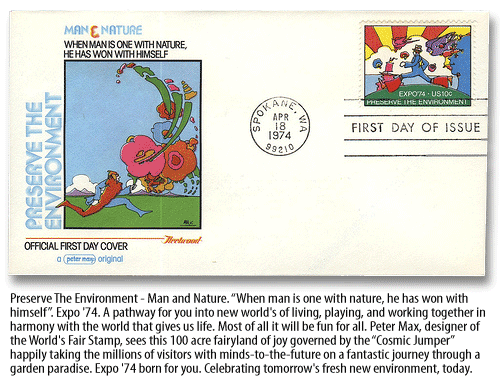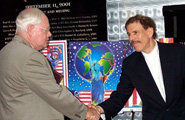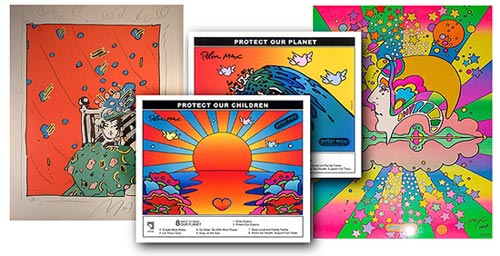Peter Max is one of the most public and accessible artists of our era. His appeal is like those of America's most enduring icons, spans all demographics, and has done so for several generations. Max's famous signature style and depicts a joyous, exuberant, sustainable world. Max has been an advocate of ecology and sustainability since the first Earth Day and was moved to create posters for Greenpeace, the Peace Corps, Save the Whales, and many more environmental causes.
Even today, when you need a Peter Max image, there's only one place to get one! From Max himself! Many other artists have attempted to emulate Max, (including me,) with not such good results. In fact, at left you see a recent NEWSWEEK magazine cover created specifically by Max for an issue relating to the era.
In 1974, Max created the first 10-cent U.S. postage stamp, with the slogan, "Preserve the Environment." He was also the Official Artist for three United Nations Earth summits and created a series of twelve U.N. postage stamps for each of the summits. As official poster artist for more high-profile global events than any other contemporary artist, Max has championed the causes of world peace, ecology, human and animal rights, and space exploration-confirming that he is not only one of America's most famous and prolific living artists, but also one of the most relevant. Max has virtually redefined the role of the artist in American culture.
Max used his work as a means of giving to the victims of the Sept. 11, 2001, terrorist attacks in the Pentagon and New York. After the attacks, he designed six posters to raise money for victims' funds. He presented prints of those six posters to hang in the rebuilt section of the Pentagon. (Read more)
"They cost $150 a piece," Max said, "and $145 of that goes to the victims' funds. So far, the prints have raised "hundreds of thousands of dollars."
I tried to purchase one, but by the time I got there, unfortunately, they were all sold out very quickly.
You can still own an original Peter Max, and support nonprofits at the same time! At the Peter Max web site, you can support The Marine Mammal Conservatory, a non-profit all-volunteer organization, who rely 100 percent on monetary donations, by purchasing any of 5 posters. The proceeds will go towards the rescue and rehabilitation of marine mammals. Proceeds from these six posters will benefit the Marine Mammal Conservatory. See them and purchase them here.
Newsweek Voices features a nice slideshow of Max's work, along with commentary from the artist himself on each slide. 'We Wanted to Change the World' A history tour of 1968 through the eyes and art of Peter Max, in conjunction with the above mentioned Newsweek cover design. You can also take a little tour of Peter Max work at Laurel Neustadter's "Artists Journey" blog.
Most importantly though, visit Peter himself at his web site PeterMax.com. Even if you weren't around during the '60s and '70s, the lively vibrance of his art transcends all ages and backgrounds. It's just fresh and invigorating! I think you'll like it!
Until next time... keep on drawing!

Fred Showker, Editor/Publisher
* Describe what it is
* Describe its function
Max is a famous artist who rose to popularity during the 1960's and early 70's for his pop culture poster work. Peter Max Finkelstein was born October 19, 1937 in Germany. His family escaped Germany in 1938 and emigrated to China. The family settled in Israel in 1948. Max attended art school in Paris for 6 months, he then moved to Brooklyn in 1953.In 1956, Max began his formal art training at the Arts Students League in Manhattan, studying anatomy, figure drawing and composition.
* Describe where you saw it
Graphic Design.com
* Discuss the style of the design & typography
Peter Max had a unique style that was a part of the psychedelic movement in graphic design. His work was much imitated in commercial illustration in the late 1960s and early 1970s.
* Discuss the quality of the artwork
His reputation speaks for itself.
* Discuss what attracted you to the piece
I thought it would be nice to end the semester featuring a living artist who I have met.










0 comments:
Post a Comment